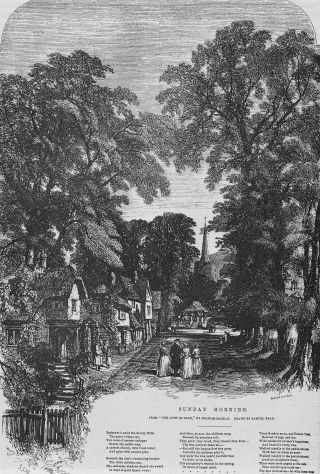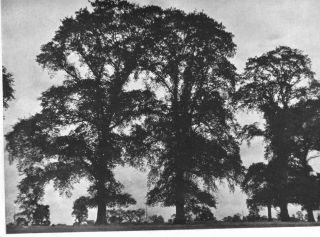Victorian drawing showing typical English elms



Worcestershire Record No. 18 April 2005 p. 20-21
Harry Green
The Natural History Museum, the Ramblers’ Association, and English Nature in collaboration with nine partner organisations, joined forces in 2003 in an initiative to map Britain’s Elm trees. The on-going Project is known as ELM MAP and the aim is to record basic information on the location and state of large elm trees. Very few are left following the ravages of elm disease which struck the country around 1970 and is thought to have killed about 20 million big elm trees, mainly English Elm Ulmus procera. These trees were typically open grown hedgerow trees of the English countryside and many were probably a product of the 19th century enclosure acts. English elm suckered along the new hedges and grew rapidly to produce excellent tough timber widely used for everything from chair seats to coffins, water pipes to cart wheel hubs.
Worcestershire and Warwickshire contained large numbers of hedgerow elms the Warwickshire weed! Only those of us above a certain age remember the vast English elms, very tall trees shaped like billowing clouds. One of my favourite spring time sights was one the sight of them turning red in spring when the tiny flowers appeared. Rookeries were once usually in the tops of elms and I have another vision of a young tree climber trying to reach their nests by scrambling up the brushwood of epicormics on a vast trunk and spraying broken twigs in all directions. Coming down was a problem!
Wych elm Ulmus glabra was also common in Worcestershire, usually as a woodland tree, and there are various other species, hybrids and horticultural varieties in the county.
When Elm Disease kills a big tree the roots often remain alive and new growth rises from them. When the growing tree reaches 20-30 feet in heigh and bark thickens it is colonised by elm bark beetles carrying the causative fungus and the tree top is killed again. This cycle constantly repeats itself so no large trees grow. Occasionally elms appear resistant to the disease and grow into big trees
The ELM MAP has recorded around 200 big elms so far. Some of these may have been in Worcestershire. We know of a few large trees but tere are no proper records in the county. So this article is a request to add elms to the hunt for ancient trees and send us records, including any that have already been sent to the ELM MAP. We should like the same information as for ancient trees. The most important is an accurate map reference, preferably an 8-figure grid reference, or a map with a dot marking the location of the tree. A photograph would be very helpful. The date of sighting, your contact details and a measurement of the circumference at chest height would also be useful.
Victorian drawing showing typical English elms
|
 |
| Another Victorian drawing of typical village elms. Elms are rarely very long-lived (compared with oak). The centres rot and become hollow. The huge trees may then drop branches for no obvious external reason and are prone to blow over in high winds. Hence the old saying quoted by Edlin (1970) " Ellum hateth Man, and waiteth" . I was told stories as a kid of elm branches falling without warning on cattle sheltering in the shade beneath them! | |
| The caption shown left appeared in a national newspaper together with an article on the Elm Map. Some confusion between beetles and the Beatles by the sub-editor, never mind the pouncing Beatles. | |
 |
|
| A common sight before 1970 - hedgerow elms |
Botanically, elms are a complex and difficult group. Identifying English elm with its small rough leaves, and Wych Elm, with its very large rough leaves, is fairly easy but the rest are difficult. Will Watson (2000) gave some information in Worcestershire Record number 9 and M Coleman’s (2002) article in British Wildlife is helpful (see below).
References:
| COLEMAN, M. 2002. British elms. British Wildlife 13:390-395. | |
| EDLIN, HL. 1970. Trees, Woods and Man. Collins New Naturalist Series. Third revised edition. | |
| RICHENS, RH. 1983. Elm. Cambridge University Press. | |
| WATSON, W. 2000. Elms in Worcestershire. Worcestershire Record, 9, pages 31-33. | |
| WILKINSON, G. 1978. Epitaph for the Elm. Hutchinson of Arrow edition in 1979. |
| WBRC Home | Worcs Record Listing by Issue | Worcs Record Listing by Subject |